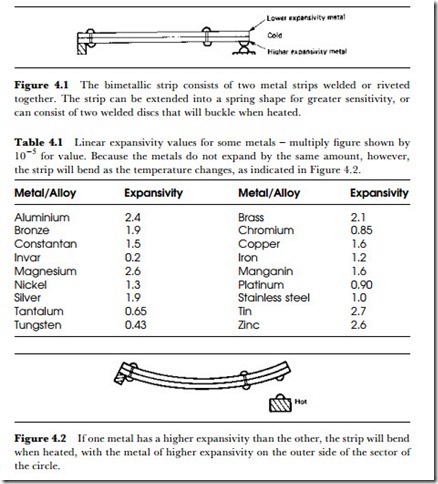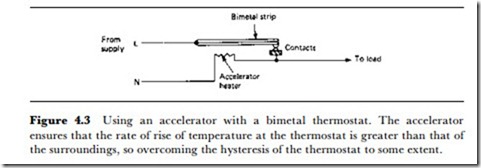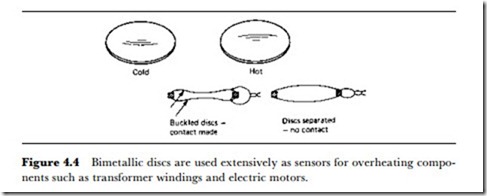Heat and temperature
The physical quantity that we call heat is one of the many forms of energy, and an amount of heat is measured in the usual energy units of joules. The quantity of heat contained in an object cannot be measured, but we can measure changes of heat content that take place when there is a change of temperature or a change of physical state (solid to liquid, liquid to gas, one crystalline form to another). In this sense, then, temperature is a measure of the level of heat for a material whose physical state has remained unchanged. The relationship between temperature and energy is very similar to that between voltage level and electrical energy.
The temperature sensors that we use all depend on changes that take place in materials as their temperatures change. Transducers for electrical to thermal energy make use of the heating effect of a current through a conductor, but transducers for thermal to electrical energy are not so direct, and in accordance with the laws of thermodynamics will require a temperature difference to operate, taking heat in at a higher temperature and discharging some heat at a lower temperature.
The bimetallic strip
Thermal sensing is important for the detection of effects as diverse as fire, overheating, or the failure of a freezer. The simplest type of thermal sensor is the bimetaLLic type, whose principle is illustrated in Figure 4.1. A compound strip is formed by riveting or welding two layers of metals, chosen so as to have very different values of Linear expansivity. The linear expansivity (old name, expansion coefficient) is the fractional change of length per degree change of temperature and for all metals is positive,
meaning that the strip expands as the temperature increases. Table 4.1 shows expansivity values for some metals in units of K-1 x 0-5.
This bending action can be sensed by a displacement transducer of any of the types discussed in Chapter 2, but is more often used to operate switch contacts, usually with the strip itself carrying one contact. The conventional type of bimetallic strip element is still to be found in some thermostats, although the strip is very often arranged into a spiral. This allows for much greater sensitivity, since the sensitivity depends on the length of the strip. The amount of deflection can be fairly precisely proportional to tempera- ture change if the temperature range is small.
Thermostats of this type, however, have an undesirably large hysteresis, so that, for example, a thermostat set for a nominal 20oC might open at 22oC
and close again at 18oC. This leads to undesirable temperature swings which can nullify the use of a thermostat. For example, with a bimetallic thermostat used to control room temperature the effect of the hysteresis is likely to be that the occupants of a room ignore the thermostat and turn the radiators directly on or off, or use the thermostat simply as an onjoff switch. The hysteresis of the simple bimetal thermostat can be reduced by the use of an acceLerator, consisting of a high-value resistor placed close to the element. The principle is that when the thermostat contacts close to switch on heating in a room, current is passed through the accelerator resistor (Figure 4.3) so that the rate of heating within the thermostat is faster than outside. See Chapter 10 for details of switch contacts.
This leads to the thermostat points opening before the same temperature is achieved in the room outside. The current through the accelerator resistor then switches off, and the thermostat will then cool more rapidly than the room so that the switch-on is more rapid than would otherwise be the case. The use of an accelerator, however, can lead to the desired working temperature being achieved very slowly or not at all in cold weather, and much too rapidly in hot weather. This has led to the use of more sensitive devices for thermostat use, based on thermistors (see later in this chapter).
The bimetallic strip exists in several physical forms, and one particularly useful form is the disc (Figure 4.4). For a change of temperature, a bimetallic disc will abruptly buckle giving a snap-over action that requires no form of assistance. This is the basis of the small thermal switches that are used for overheating protection in electronic equipment. These thermal switches can be bolted to heat sinks, small motors, transformers, jug- kettles, or other components that are likely to overheat and have a metallic surface.
Thermal switches can be bought as normally open or normally closed types, depending on whether they are to be used to detect rising or falling temperatures. The pre-set nominal temperatures have temperature hysteresis of the order of 3-5oC on each side of the set temperature since no accelerator is used. For more precise control, units that use long bimetal strips can be obtained with smaller hysteresis and variable setting temperature.
All types of long-element bimetal strip thermostats should be recalibrated at intervals, since the strip is subject to gradual changes (creep) that affect the thermostat setting.


